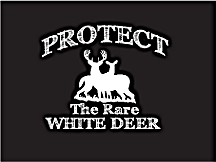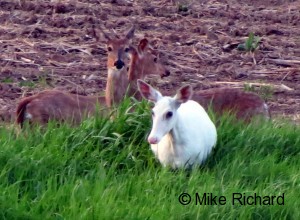
A Look At the Laws
What is the current law on hunting white and albino deer in Wisconsin?
White and albino deer are currently protected in all of Wisconsin. Here is the current State Statute from Chapter NR 10 (Game and Hunting) of the Administrative Code of the Department of Natural Resources (October 2019).
NR 10.02 Protected wild animals. The following wild animals are designated protected. No person may take, attempt to take, transport or possess any protected wild animal or its carcass at any time unless expressly authorized by the department.
(3) Albino and white deer which have a coat of all white hair except that the hair on the tarsal glands, head or parts of the head may be a color other than white. For the purposes of this paragraph, white hair that has been discolored or stained by blood, soil or similar materials shall continue to be considered white hair.
The History of white deer protection in Wisconsin

White deer have been protected in most of Wisconsin for over 80 years. The first law protecting white deer was enacted in 1940 (from Otis S. Bersing, A Century of Wisconsin Deer). This is one of the longest traditions of white deer protection in any state.
In 2008 protection of white deer was removed in CWD (chronic wasting disease) management zones in southern Wisconsin. The rule change, made at the recommendation of the CWD Stakeholder Advisory Group, was part of an effort to drastically reduce deer numbers in the affected counties, even though white deer are extremely rare and statistically insignificant.
In 2014, the Deer Trustee Report Rule Package, a composite recommendation for statewide deer hunting rule changes, temporarily reinstated white deer protection in CWD zones. The law became permanent in 2015. Sauk County Representative Fred Clark was instrumental in getting the white deer proposal added to the package.
Piebald, or partially white, deer are not protected in Wisconsin, and white deer law does not, unfortunately, discriminate between piebalds, with typically mixed brown and white coats, and all-white deer that have only a small spot of brown on them (see video and photo at top of home page).
This loophole in the law has resulted in the needless deaths of some locally prized deer that were otherwise pure white. White deer advocates are still working to broaden the legal definition of protected deer to include predominantly white deer.
What is the penalty for shooting a white deer?
In Wisconsin, illegal shooting of a white or albino deer (at least in 2011) would result in a fine of $303.30 and surrender of the deer to the state. Illinois is not so lenient: Killing a white deer is a Class B misdemeanor, punishable by up to $2,500 in fines or 180 days in jail, with confiscation of the deer. In Michigan, prior to the repeal of protection in 2009, penalties for killing a white deer were even steeper: fines of $200-$1000, payment of the assessed value of the deer, and loss of hunting privileges for three years.
Does this include piebald or partially white deer?
Piebalds are legal to shoot in Wisconsin. Even though the word piebald conjures up images of “pinto” horses or animals with large splotches of color, current Wisconsin law takes the definition of piebald to an extreme. If there is even a small spot of brown on the animal’s body (with a few exceptions–see below), the deer is considered a piebald and is totally legal to hunt anywhere in the state.
According to the Warden Wire (Wisconsin DNR/Bureau of Law Enforcement): “A deer that has some brown hair, even if only a small patch, on any part of the body that is not part of the head, hooves, or tarsal glands, is not protected and may be harvested, tagged and registered by a hunter if they have a valid tag for that type of deer (buck or antlerless deer).”
The white buck that was shot near Leland had a a brown spot the size of a half dollar on its side and would have been legal to shoot even outside the CWD zone. This is a very technical demarcation and should not qualify an otherwise all white animal for hunting. As far as reproduction, the piebalds also carry white genes, so their loss represents a further diminishing of white genes in the overall herd.

